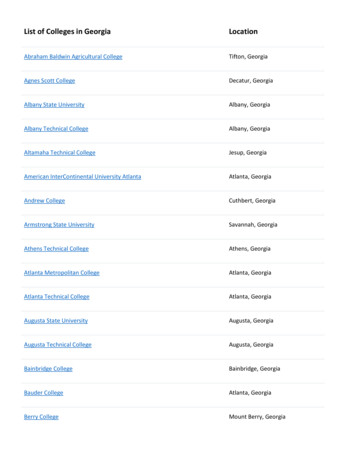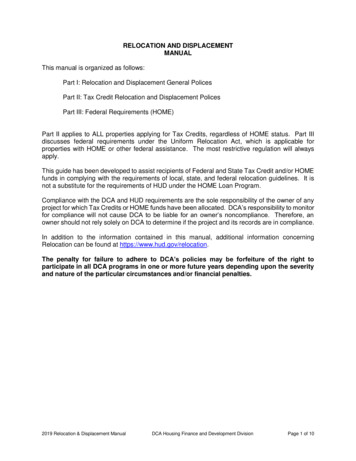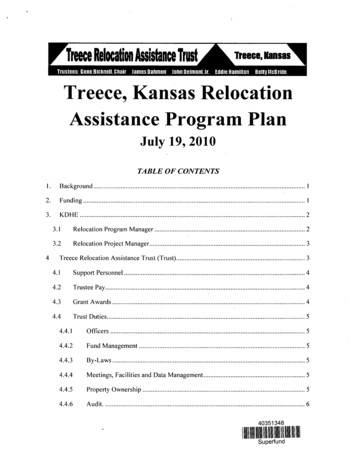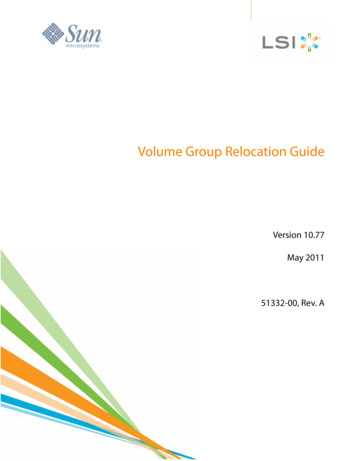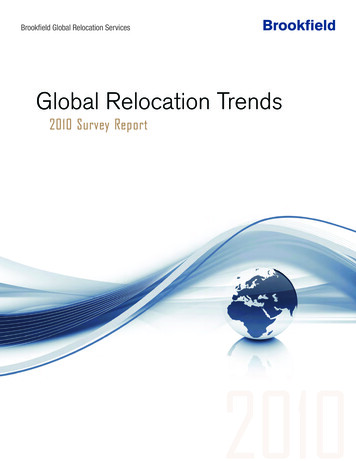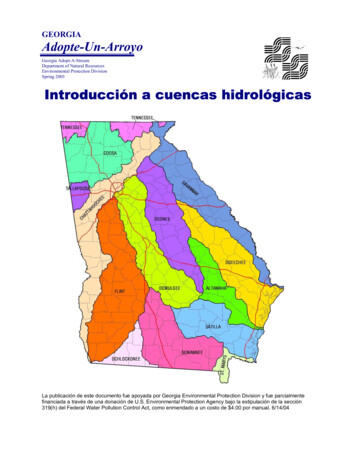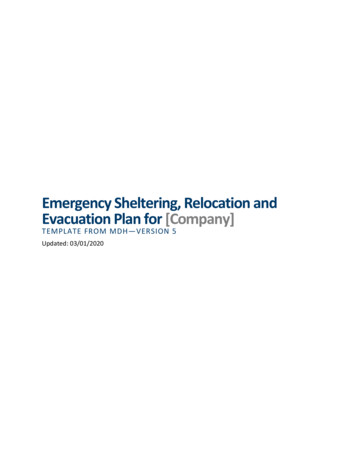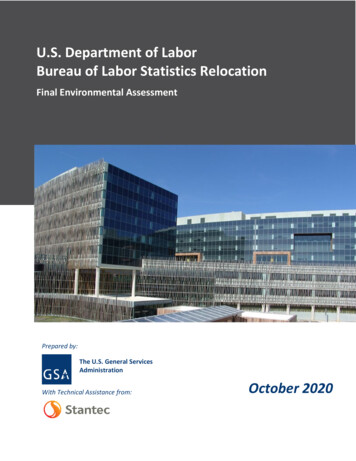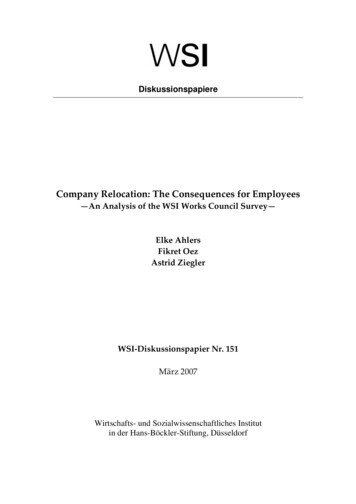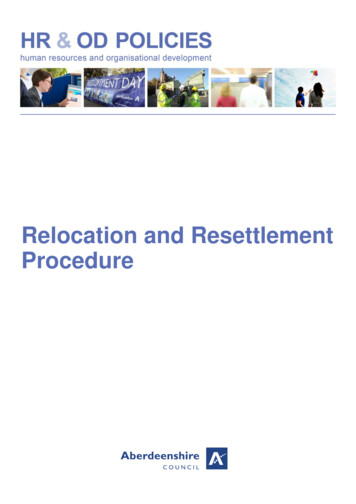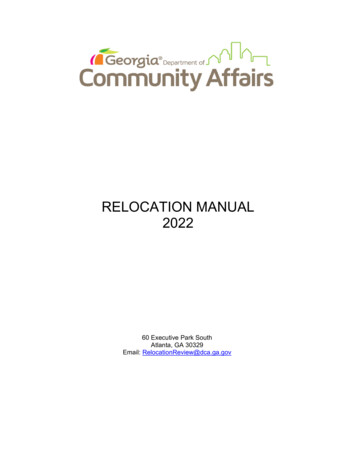
Transcription
RELOCATION MANUAL202260 Executive Park SouthAtlanta, GA 30329Email: RelocationReview@dca.ga.gov
TABLE OF CONTENTSINTRODUCTIONPurpose . Page 3Applicable Regulation and Eligibility . Page 3 – 4ADVISORY SERVICES . Page 4 – 6Applicant’s Relocation Specialist . Page 4Advisory Services. Page 5 – 6TENANT NOTICE REQUIREMENTS . Page 6 – 11Notices . Page 7 – 9Additional Notices – Not Required . Page 9 – 10RAD Notices . Page 10 – 11RESIDENT ENGAGEMENT . Page 12 – 13Interviews . Page 12Surveys . Page 12Meetings . Page 12 – 13GRIEVANCES AND APPEALS . Page 13 – 14TEMPORARY RELOCATION . Page 14 – 16Resyndication . Page 16IN PLACE REHAB WITH WAIVER . Page 16 – 17DISPLACEMENT . Page 17 – 19Permanent Displacement . Page 18Determining Permanent Displacement Status . Page 19HOUSING ASSISTANCE. Page 19 – 25General Requirements . Page 19Temporary Relocation Housing Options . Page 20 – 22Permanent Displacement Housing Assistance . Page 22 – 25RESIDENT MOVING ASSISTANCE . Page 25 – 26General Requirements . Page 25 – 26RELOCATION CONSIDERATIONS . Page 26 – 30Economic Displacement. Page 26 – 28RAD Right to Return . Page 28Student Household. Page 28Underhoused. Page 28 – 29Right-Sized . Page 29Over-Housed . Page 2990 Occupants . Page 30NON-RESIDENTIAL TENANTS. Page 29 - 32Summary of Assistance . Page 30Moving and Reestablishment Costs . Page 30 – 31Ineligible Expanses . Page 31 – 32DOCUMENTATION AND ADMINSTRATION . Page 32 – 36Core Application and Relocation Plan . Page 32Waivers and Project Concept Change . Page 32 – 33Occupancy Records . Page 33 – 34Temporarily Relocated and Permanently Displaced Household Files . Page 34 – 35Permanent Move Records . Page 35 – 36Quarterly Reporting, Visits, and Compliance . Page 36DEFINITIONS . Page 37 – 43QUICK SUMMARY OF RELOCATION PROGRAMS . Page 44Eligibility . Page 44Assistance . Page 45 – 46REGULATIONS AND RESOURCES . Page 472 Page
INTRODUCTIONPURPOSEThe Georgia Department of Community Affairs (DCA), on behalf of the Georgia Housingand Finance Authority (GHFA), the state housing agency, requires that all projects thatreceive a Federal Tax Credit Allocation and/or funded with a HOME loan must ensurethat all reasonable steps are taken to minimize the displacement of persons (families,individuals, businesses, and/or nonprofit organizations) as a result of the construction orrehabilitation of the development. This manual explains policies and processes thatrecipients of Federal and State Tax Credit, Uniform Relocation Act-triggering funds, andprogram-specific funds, must follow and implement. It is not a substitute for therequirements of the Uniform Relocation Assistance and Real Property Acquisition PoliciesAct (URA) of 1970 or programs’ regulations.DCA will review applications for compliance with the DCA, IRS, and HUD policies andregulations. DCA, as the direct recipient of HUD funds, is responsible for enforcingcompliance on applications with DCA-allocated HUD funding and tax credits. DCA is alsoresponsible for determining the feasibility and analyzing the impact on residents,regardless of funding source. DCA reserves the right to review and monitor compliancefor federal funding that DCA did not provide.While developing an Application and determining feasibility, Applicant must adjust unitincome and funding designations to minimize displacement. In determining whetherdisplacement can occur, DCA will review the underwriting and the impact of the proposalon the residents, the affected businesses, nonprofits, and farms, and on the entirecommunity. Any displacement of existing residents is subject to DCA’s prior approval.The development’s applicable fraction will be adjusted if the Application did not accuratelyreflect resident eligibility.If, at any point, DCA’s policies are not adhered to, DCA reserves the right to the followingactions depending upon the severity and nature of the particular circumstances: Halt relocation until cured; Delay or Fail threshold review of Application; Delay delivery of 8609s until issues are resolved; Incur financial penalties; or Deem the Applicant ineligible to participate in all DCA programs in one or morefuture years.APPLICABLE REGULATION AND ELIGIBILITYDCA requires relocation review and assistance for residents and non-residential tenantsto all developments with tenants, including businesses, nonprofits, and farms. In additionto assistance the following requirements must be met:1. Minimize displacement of existing residents and non-residential tenants.2. Advise them of their legal rights.3. Provide relocation counseling and assistance.4. Compensate residents and non-residential tenants in a timely manner forrelocation made necessary by such activities. And3 Page
5. Residents and non-residential tenants dissatisfied with determinations or benefitshave the right to submit grievances for review and appeal determinations.Federal law protects owners and residents from uncompensated displacement in certainsituations. Subrecipients/Developers (from now on, “Applicant”), who intend to receive oraccept federal funding (including HOME, NHTF, and CDBG) for acquisition and/orrehabilitation and reconstruction, must follow applicable Federal Guidelines in addition tothose outlined by DCA. When more than one regulation applies to a unit, the moststringent one applies. Sections specific to federal funding regulations (such as URA) aredepicted with the name of the regulation or program in bold.The Uniform Relocation Assistance and Real Property Acquisition Policies Act (URA) andSection 104(d) are the most common federal guidelines which apply. However, they maynot be exclusively applicable. Requirements for program-specific funding (HOME, NHTF,and CDBG) and federal funds not allocated by DCA (such as RAD) are summarized inthe manual, when necessary for purposes of DCA review.ADVISORY SERVICESAPPLICANT’S RELOCATION SPECIALISTDCA requires that the Applicant engage a Relocation Specialist to provide the followingrelocation advisory services to work with Residents and Non-Residential Tenants.1. To determine the most appropriate relocation/displacement strategy.2. To understand the Relocation/Displacement Plan and why they must relocate.3. To understand the benefits/assistance they will receive. And,4. To understand their protections and rights under DCA and HUD policy asapplicable.Advisory services are encouraged to be done by a third party, such as a nonprofit,advocacy group, relocation specialist, or local government. The entity providing advisoryservices must have prior experience in face-to-face community engagement among thetenancy served.The Applicant’s Relocation Specialist’s resume must be submitted at Application. Theresume must show the following:1. Experience in direct, in-person interactions with Residents and Non-ResidentialTenants.2. History of providing relocation guidance and implementing assistance. And,3. Relevant certifications and training (such as the Relocation Assistance 500 Seriesfrom the International Right of Way Association). For a relocation specialist that isnot certified, include completed course descriptions.a. URA: Relocation Specialist must have completed all available, applicablemodules of URA the HUD Way (www.hudexchange.info/trainings/ura-thehud-way/).4 Page
ADVISORY SERVICES1. Relocation Plana. Determine the most appropriate relocation/displacement strategy. Write theRelocation Plan and complete the Relocation Displacement Workbook.2. Claims, Payments, and Grievancesi. Assist Residents and Non-Residential Tenants in preparing claims.ii. Process claims and provide advance payment when needed. And,iii. Respond to grievances promptly. Refer Residents and NonResidential Tenants to DCA.3. Resident Consultation and Service Administrationa. No Coercion:Applicants may not request or coerce Residents and Non-ResidentialTenants to waive their rights to payments and services. Applicants may onlyprovide incentives to Residents and Non-Residential Tenants who acceptrelocation assistance if these incentives are in addition to entitled relocationassistance and if it is documented outside of the project budget. Sourcedocumentation is required and specifies the lines of communication.i. Waiver of Assistance: DCA may accept a written statement from thedisplaced person that states that they have chosen not to acceptsome or all of the payments or assistance to which they are entitled.Any such written statement must include:a. A signed copy of the NOE or NND.b. The statement must specifically identify whichassistance or payments they have chosen not toaccept. The statement must be signed and dated andmay not be coerced by the Applicant, Project Team, orany Project Team Participants, including Applicant’sRelocation Specialists. Andc. Resident and Non-Residential Tenant explanation ofwhy they chose to move.ii. RAD: No tactics may be employed to pressure Residents and NonResidential Tenants into relinquishing their right to return oraccepting alternative housing options. A Resident’s lease may notbe terminated due to the resident seeking to exercise their right toreturn.b. Non-Responsive HouseholdsIf a household that is required to relocate ceases to respond to advisoryservices and/or notifications prior to the relocation date, the applicant shouldconfirm that the household continues to occupy the property. If so, outreachand notifications continue until the household becomes responsive or canbe documented as non-compliant as described below. If the household hasalready vacated the property, the applicant is responsible for documentingto DCA that the move was voluntary.5 Page
Good faith efforts must be made to contact and locate a household thatdoes not readily respond to relocation requests and advisory services. Ahousehold is considered non-responsive after:i. A minimum of three (3) attempts using the last known contactinformation that results in no meaningful reply. Attempts should bethirty days or less.ii. At least one (1) request to the applicant for updated contactinformation or other assistance contacting the household that doesnot produce new information and / response from the household.c. Non-Compliant HouseholdsHouseholds who fail to cooperate and vacate the property in a timelymanner may be subject to allow the relocation activities to continue. In theevent a displaced household, as defined in 49 CFR.24.2(a)(9), fails tovacate the assisted property by the established Move Out date, thehousehold may be evicted “for the project” without penalty to the applicant.The household retains their entitlement to relocation assistance andpayment, provided a suitable permanent dwelling is occupied, and paymentclaims are submitted within the required timeframes. Legal fees incurred inthe eviction, if any, are not URA eligible expenses.4. URA: See 49 CFR § 24.205(c) - Relocation planning, advisory services, andcoordination. This includes an offer to transport all displaced persons to inspecthousing to which they are referred.5. Communicatea. Follow required notification and advisory service procedures to minimize therisk that families leave the property because they lack information or are notinformed of the project’s relocation plans or their rights. Resident’s and NonResidential Tenant’s rights should be presented in an easy-to-understandformat. Foster communication during the work process through regularnotices and regular Residents and Non-Residential Tenants’ meetings. Allnotices must be delivered in a timely manner. Notices must be personallyserved with a signature receipt or sent by certified or registered first classmail, return receipt requested. Samples of notices and posters are includedon the DCA website under Relocation Forms section. They must be clearand easily understood, as well as translated into all primary languagesspoken by Residents and Non-Residential Tenants.b. Communication (notices, meetings, schedules) within the requiredtimeframe and interviewing heads of household, ensures Residents andNon-Residential Tenants understand the relocation processes and theirrights.TENANT NOTICE REQUIREMENTS6 Page
Applicants are responsible for informing impacted residents and non-residential tenantsof their rights, sending the required information and notices, and providing relocationassistance.All HUD funded and/or related developments must follow all URA Guidance, includingcommunication processes, according to the HUD Manual 1378. DCA is required by HUDto oversee all URA procedures and therefore may request copies of all notices providedto residents.Resident communication must:1. Use applicable DCA-provided notice templates or relevant guide form, from HUDManual 1378.2. Adjust notices to reflect individual households’ needs and assistance.3. Translate notices (if applicable) to preferred language and readingaccommodations.4. Include the Applicant’s Relocation Specialist and/or Applicant contact information(phone, email, and physical address). And,5. Be personally served with a signature receipt or sent by certified or registered firstclass mail, return receipt requested.NOTICESGeneral Information Notice (GIN)1. The GIN informs all occupants of a possible project and of their rights under theDCA Relocation Manual and other applicable regulations.2. This notice advises the household not to move at this time and advises them of thelikelihood of potential relocation or displacement.3. This notice must be provided between the ION Date and at least 15 days beforeinitial submission to DCA of the application for federal funding or assistance.4. If an Application was previously denied, the GIN must include the following “Thisis the (ie. Second, third, etc.) application for funding to rehabilitate/redevelop thebuilding in which you live. Please disregard previous notices regardingredevelopment.”5. URA: Notice must include HUD’s brochure(www.hudexchange.info/programs/relocation/ publications/).Notice of Eligibility (NOE)1. Notice provided to persons who will be permanently displaced.2. The NOE must be distributed promptly after the Initiation of Negotiations and morethan 90 days before the moving date.3. This Notice must be specific to the person and their situation so that they will havea clear understanding of the type and amount of payments and/or other assistancethey may be entitled to claim. (49 CFR 24.203(b)). The NOE must include thefollowing:a. Must include three options for Comparable Replacement Dwellings.b. The terms of the moving and housing assistance.7 Page
c. The estimated amount of assistance based on the displaced person’sindividual circumstances and needs.d. The procedures for obtaining the assistance. And,e. Options to appeal.Notice of Non-Displacement (NND)1. Notice provided to persons who will be temporarily relocated and not permanentlydisplaced for a project.2. Such persons, however, may be required to move to another unit onsite or offsitetemporarily while the property is developed.3. If an accurate and timely NND was provided before a tenant moves and the tenantvoluntarily moves before the designated date, the tenant is presumed to beineligible for relocation assistance. (URA – see HUD Handbook 1378, 1-4(AA).4. NND must be distributed promptly after the Initiation of Negotiations and more than60 days before moving date. Notice must include the following:a. The terms of the moving and housing assistance.b. Rent upon return.c. Any projected changes to lease terms at lease renewal.d. Any change in house rules, community standards, and other policies. And,e. Whether tenant will not return to the same unit and if not, specifics aboutthe different Return Housing.Combined Notice of Eligibility and Notice of Non-Displacement (NOE/NND)1. Notice provided to persons who are temporarily relocated for more than 12 monthsand are offered displacement assistance.2. Such households have a choice between:a. Temporary relocation for an agreed upon period of time.b. Move permanently to the home the tenant temporarily moved to, if it isavailable. Or,c. Move permanently to another location that is decent, safe, and sanitary.3. The NOE/NND must include all provisions of an NOE and an NND.4. NOE/NND must be distributed promptly after the Initiation of Negotiations andmore than 90 days before the moving date.90-day Notice1. Notifies tenant of moving date and moving logistics for Permanent Displacementor any Temporary Relocation circumstances.2. Notice must:a. Be distributed more than 90 days before tenants will be required to move.b. Be distributed after, or with, the NOE/NND.c. Include the specific date by which tenants must move or provide an estimateof the date. If the latter, the Notice of Moving Date must be distributed morethan 45 days prior to the date tenants must move.d. If not in the NOE, must identify Comparable Replacement Dwellingavailable for the resident’s moving date. Include details in this notice unlessprovided earlier. And,8 Page
e. Include moving logistics, if move is not a self-move.Combined NOE and 90-Day Notice1. Where time to begin work on the project is critical, policy permits an NOE and a90-Day Notice to be combined into one Notice and issued on or before ION (e.g.,where moving tenants before snowfall will enable the project to move forward withroof replacements).2. All persons must still be provided with a minimum of 90-days’ notice prior torequiring that they move, unless DCA approves otherwise. If URA is triggered, theurgent need provisions in 49 CFR 24.203(c)(4) must also be met.Notice of Moving Date/30 Day Notice1. Informs tenants of the specific date by which they must move.2. Must be provided at least 30 days prior to the date by which tenants must move.Relocation Poster1. Within 15 days after award, the Applicant or property manager must post at least:a. One (1) relocation notification poster in the project rental office and one (1)poster in each building clearly visible inside the building entrance.b. These must:i. Remain in place for the duration of the relocation period whenresidents are living on the property.ii. Be replaced if damaged or destroyed. And,iii. Be at least 11 by 17 inches and a minimum 14-point font or greaterto ensure its readability.PermanentDisplacement1. GIN2. Relocation Poster3. Notice ofRelocationEligibility (NOE)with ComparableReplacementDwelling form4. 90-Day Notice5. Notice of MovingDate/30-DayNoticeTemporaryRelocation1. GIN2. Relocation Poster3. Notice of NonDisplacement4. 90-Day Notice5. Notice of MovingDate/30-DayNoticeADDITIONAL NOTICES – NOT REQUIREDNotice of No Relocation9 PageRelocation 12 Months1. GIN2. Relocation Poster3. Notice of NonDisplacement4. 90-Day Notice5. Notice of MovingDate/30-DayNoticeNon-ResidentialTenants1. GIN2. Relocation Poster3. Notice of NonDisplacement orNOE/NND (ifrelocation is morethan 12 months)4. 90-Day Notice5. Notice of MovingDate/30-DayNotice
If Applicant does not receive award and/or sale of property does not go through, Applicantshould provide written notice to residents to inform them of the change and that there willno longer be potential to move.Move-In Notice1. Notifies residents and non-residential tenants, that the development may berehabilitated or demolished and reconstructed and that they will not be eligible forrelocation assistance.2. URA only: Written notice provided to a person who is interested in moving into adevelopment after the date an Application for federal assistance was submitted(often referred to as a “subsequent occupant”). If the person is provided with sucha Notice (1) before leasing and occupying the property and (2) agrees to occupythe property under the terms of the notice, the person is not eligible for relocationassistance.3. Non URA Eligible funding sources, do not provide a Move-In Notice.RAD NOTICESSee HUD Notice H 2016-17 – Section 6.6. Resident Relocation Notification (Notices) –for more detailed information.RAD Information Notice (RIN)1. Informs all occupants of a possible project and of their rights under the RelocationAssistance Demonstration (RAD).2. This Notice is to be provided to residents at the very beginning of the RADconversion planning processGeneral Information Notice (49 C.F.R. § 24.203(a))1. The purpose of the General Information Notice (GIN) is to provide informationabout URA protections to individuals who may be displaced as a result of federallyassisted projects involving acquisition, rehabilitation, or demolition.2. A GIN provides a general description of the project, the activities planned, and therelocation assistance that may become available.3. A GIN shall be provided to any person scheduled to be displaced as soon asfeasible based on the facts of the situation and may be simultaneous with issuanceof the RAD Information Notice.Notice of Intent to Acquire (49 C.F.R. § 24.203(d))1. For conversions involving acquisition, the Project Owner (the “acquiring agency”)may provide to residents of the Converting Project a Notice of Intent to Acquire(NOIA).2. The NOIA may be provided no earlier than 90 days prior to the PHA’s reasonableestimate of the date of submission of a complete Financing Plan.3. While eligibility for URA relocation assistance is generally effective on the effectivedate of the ION date, a prior issuance of a NOIA establishes a resident’s eligibility10 P a g e
for relocation assistance and payments on the date of issuance of the NOIA andprior to the ION date.RAD Notice of Relocation1. If a resident will be relocated to facilitate the RAD conversion, the PHA shallprovide written notice of such relocation by means of a RAD Notice of Relocation.A RAD Notice of Relocation is not required for residents who will not be relocated.2. Prior to issuance of the RAD Notice of Relocation, PHAs and Project Ownersshould meet with each resident household to provide preliminary relocationadvisory services and to determine their needs and preferences.3. RAD Notice of Relocation shall provide either:a. 30-days’ notice to residents who will be relocated for twelve months or less;i. This notice must also explain the reasonable terms and conditionsunder which the resident may exercise the right to return to lease andoccupy a unit in the Covered Project.b. 90-days’ notice to residents who will be relocated for more than twelvemonthsi. This notice must also offer the choice to be temporarily relocated,thereby preserving the resident’s right to return, or the choice to bevoluntarily permanently relocated pursuant to the procedures setforth in Section 6.10, together with guidance that the resident has atleast thirty (30) days to consider the choice.URA Notice of Relocation Eligibility1. After a resident has been temporarily relocated for one year, notwithstanding aprior issuance of a RAD Notice of Relocation, the PHA or Project Owner mustprovide an additional notice: the notice of relocation eligibility in accordance withURA requirements. The URA Notice of Relocation Eligibility is not required if theresident has already accepted permanent relocation assistance.2. Residents must be informed in writing that their acceptance of voluntary permanentrelocation, with the associated assistance, would terminate their right to return tothe rehabilitated project.Notification of Return to the Covered Project1. With respect to all temporary relocations, the PHA or Project Owner must notifythe resident in writing reasonably in advance of the resident’s expected return tothe Covered Project, informing the resident of the details of the return.2. Reasonable advance notice shall be 15% of the duration of the resident’stemporary relocation or 90 days, whichever is less. For short-term relocations, thePHA or Project Owner may include this information within the RAD Notice ofRelocation.RESIDENT ENGAGEMENT11 P a g e
The Applicant will be required to participate in the following engagement methods. DCAhas the discretion to engage Residents as part of the redevelopment process and canchoose which methods are applied.INTERVIEWSIf resident or non-residential tenant is unable to meet in a public space, then arrange aphone call or visit their home or business (if resident/non-residential tenant and relocationspecialist are comfortable). These one-on-one meetings need to cover the following:1. Provide information about the project, the Relocation/Displacement Plan and whythey must relocate.2. Determine the needs and preferences of the Residents and Non-ResidentialTenants to be relocated.3. Obtain basic information regarding household composition and income.4. Identify potential barriers or challenges to the relocation.5. State the benefits/assistance which the person may be eligible to receive; andassistance can include referrals to community organizations or other assistance.6. Their protections and rights under DCA and HUD policy as applicable.SURVEYSDistribute a property/redevelopment survey:1. DCA will provide a standard survey to each Applicant to distribute among allResidents and Non-Residential Tenants at the property.2. The survey (either paper, electronic, or both), must be distributed (either mailedout, hand-delivered, texted, or emailed) by property managers with returnenvelopes and stamps.3. Surveys will also need to be brought to each meeting for Residents and NonResidential Tenants to take in person if they did not already complete it.4. DCA and Applicant will receive all results.5. Residents and Non-Residential Tenants must have the option to organize,advertise, and meet onsite.
advocacy group, relocation specialist, or local government. The entity providing advisory services must have prior experience in face-to-face community engagement among the tenancy served. The Applicant's Relocation Specialist's resume must be submitted at Application. The resume must show the following: 1.
